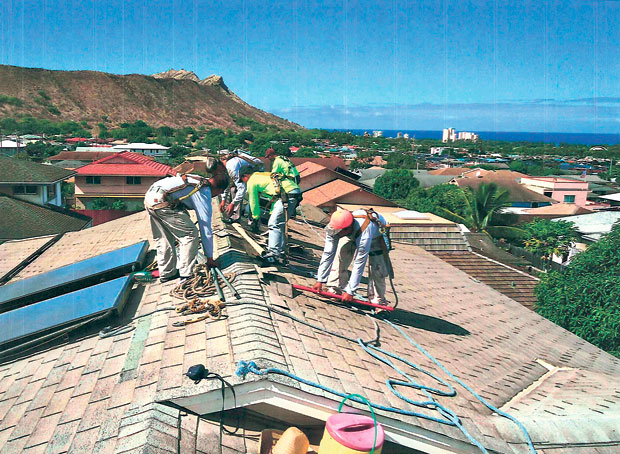Here’s a handy tool to maintain quality, value
Having a roof in good condition is very important. Roof maintenance to prevent leaks can avoid costly repairs and give you peace of mind. Common problems include wind damage, wear because of age, ventilation, wood rot, incorrect installation and moisture build up.
Shingles are the most commonly installed roofing system. Shingles come in various styles, weights, warranties and costs. An important component of a proper installation is flashing.
Flashing. Roof flashing usually made of pre-painted galvanized, copper or stainless steel prevents leakage in areas where shingles alone will not be sufficient to prevent leakage. Proper installation and application are key regarding flashing, and this is where having qualified and experienced installers is vital to a quality roof installation.
Ventilation. Roof ventilation is an often overlooked issue regarding a new roof. With rising energy costs, addressing ventilation through ridge vents, solar fans, insulation or radiant barrier systems will not only make the interior of your home cooler, but will also help maximize the life of your new roof. Proper ventilation also lowers the humidity in your attic while making your home a healthier environment.
Remove old roof? Although installing another layer of shingles without removing the existing layer will save you money, there are other issues to consider. If you have a concern regarding the sheathing (typically plywood), removing the existing roof will enable the contractor to inspect the roof deck. Also, removing the existing roof will remove the weight of your old roof, and your new roof will be nailed directly into the sheathing. There are situations where installing over an existing shingle roof is acceptable. It is best to consult with your roofing contractor to discuss your situation, needs, budget and plans.
Roofing systems. Asphalt shingles are selected 80 percent of the time because of reliability, cost and appearance. Asphalt shingle warranties will range in years from 20, 30, 50 to limited lifetime. In Hawaii’s climate, plan to reroof every 20 years (average) regardless of the quality of the shingle you select.
Metal Roofing. There are various metal roofing systems ranging from aluminum shingles, aluminum shake, met-tile, standing seam to Gerard tiles, to name a few. These systems typically have a higher cost and require more technical expertise by the installation crew. If you select from this category, be sure to do your homework prior to selecting the roofing style and contractor to ensure that you have the proper choice for your home.
There are many other types of roofing systems (coatings, membranes, brai, tile, etc.), which will be covered in future discussions.
Roofing Contractor. Protecting your home with a reliable roof will give you peace of mind and it all starts with selecting the correct roofing contractor.
Be sure to verify that your contractor has the following: a current license, worker’s compensation insurance, a clean record with RICO (state of Hawaii), is in good standing with the BBB, and is not sub-contracting out the installation.
Your contractor should review the terms and conditions of the agreement including warranties, installation process and materials.
You should receive a detailed description of the job (the contract) for your review prior to your contractor selection.
Be sure that your contactor gives you a full seven-year workmanship warranty.
Contractor response. Did your estimator arrive to your appointment promptly and answer all of your questions? When you called the office, did you get a quick response or was there a delay in a call back? Remember, it usually doesn’t get better once your roof is installed.
For a free estimate and consultation, call United Roofing at 428-7947 or visit our website at unitedroofinghi.com. United Roofing is known for quality and remembered for service.
CONTACT: 428-7947
WEBSITE: www.unitedroofinghi.com

See more articles from: United Roofing & Rain Gutters